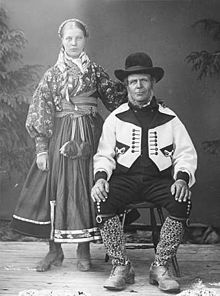Bunad

In Norway, traditional as well as constructed national costumes are called bunad (plural bunader ) . The word is derived from the norrønen búnaðr meaning or "clothes" about "Appliances", but in the modern sense, a neologism of the 20th century.
Many Norwegians wear bunad not only for folkloric events, but especially for festive events such as weddings, christenings, confirmations and on the national holiday, May 17th.
The bunaders of the various regions differ in shape and pattern, although there are also color variants for many bunaders. They are seldom made by the ladies themselves in order to serve as a confirmation gift, especially for girls. Bunader for men are much rarer.
The Bunad tradition originated in the 20th century and was inspired by similar traditions, especially in German-speaking countries in the 19th century. However, the tradition is not widespread in all population groups and was originally promoted by nationally oriented circles in the sense of national romanticism .
Bunad from the Hardangerfjord
Two girls in Trønder -Bunad on the national holiday
Girls in Asker -Bunad
Bunad from Hardanger
Setesdal -Bunad
Web links
Individual evidence
- ^ Maren Næss Olsen, "Nymotens påfunn", Ny Tid May 15, 2009
literature
- Thorbjørg Hjelmen Ugland: Eit knippe av Noregs bunader . Boksentret, Oslo 1996, ISBN 82-7683-087-0






